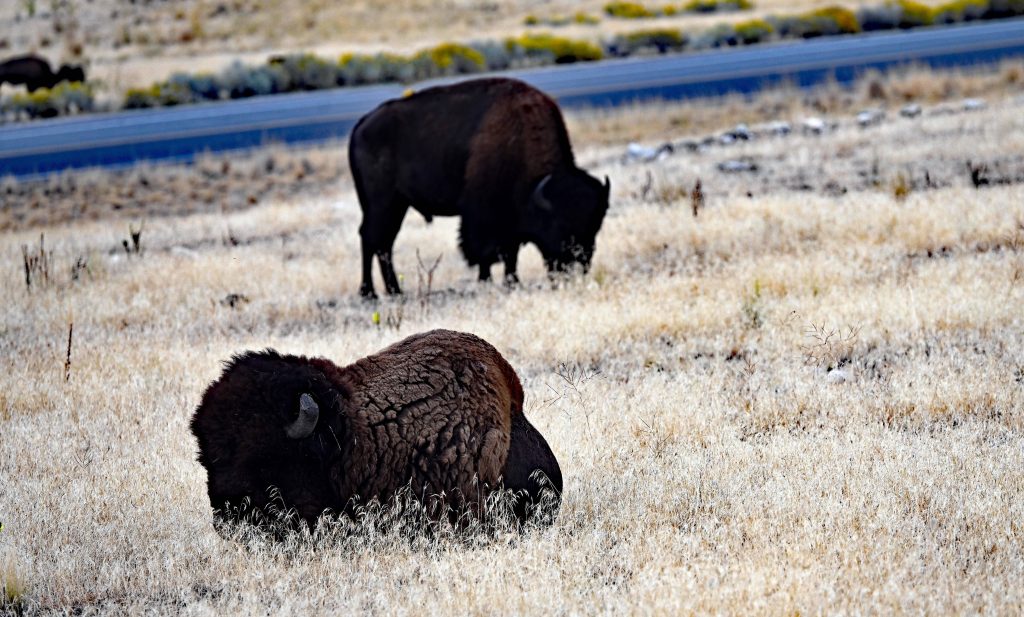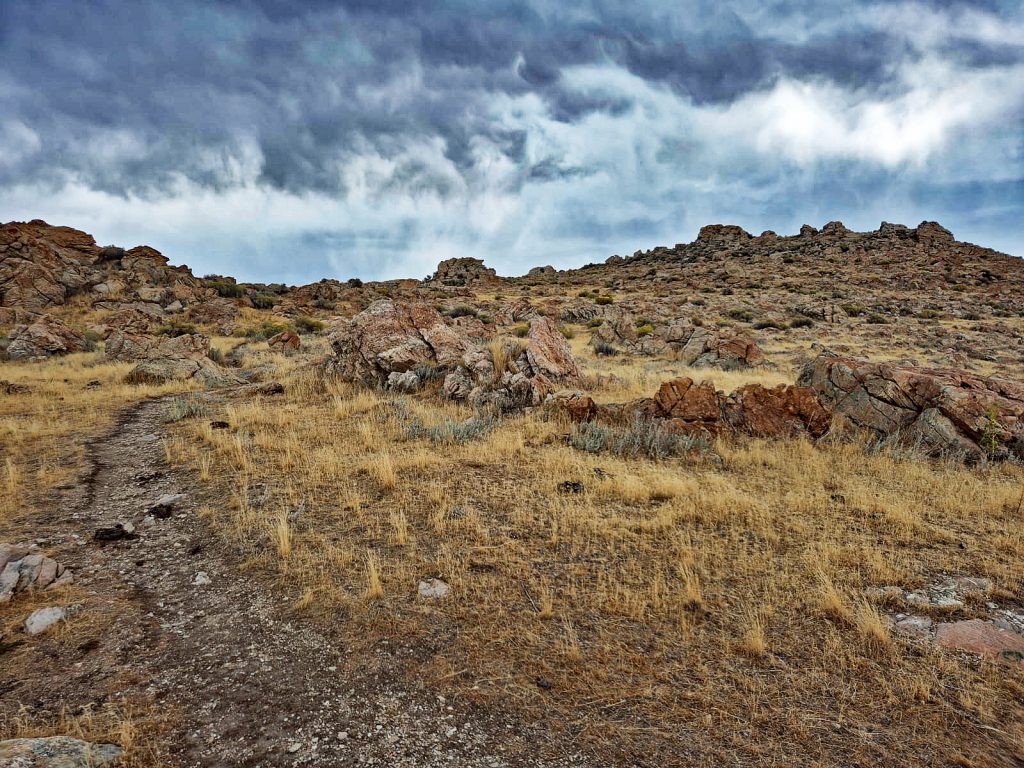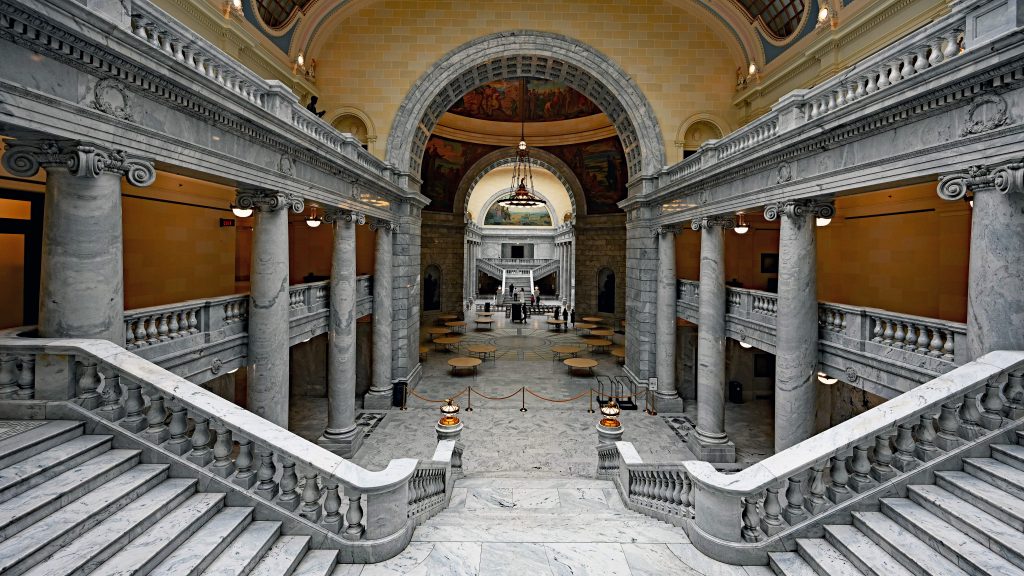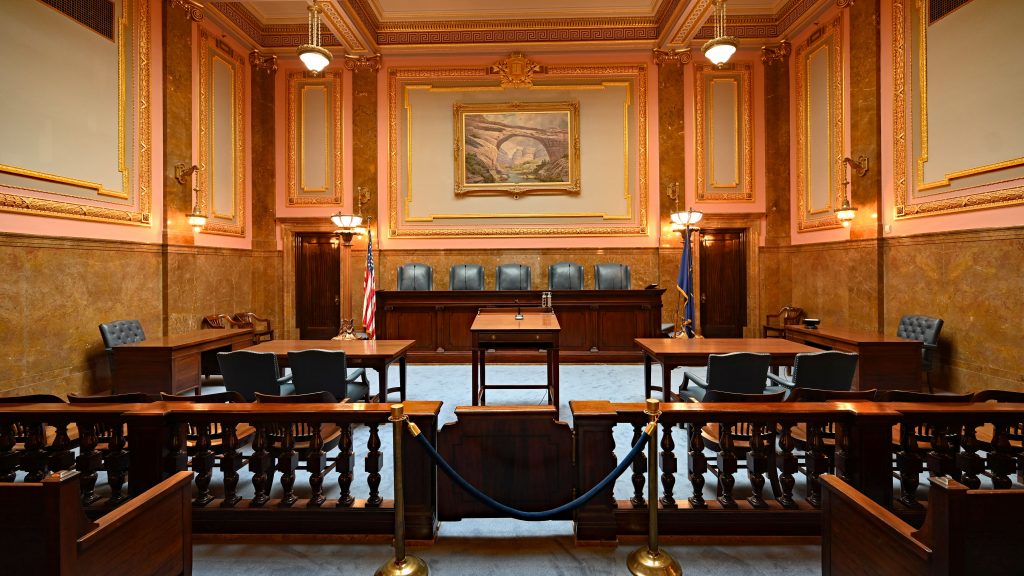October 1st–2nd, 2025
On this first morning of October, I set out from Ogden toward Antelope Island State Park, just a short drive away. The causeway leading to the island seemed to stretch endlessly across the shimmering surface of the Great Salt Lake, its water silvery-blue and still under a pale autumn sun. A faint haze floated above the surface, blurring the line between lake and sky. As I approached the island, its rugged silhouette rose from the water—gentle, rolling hills blending into rocky ridges, colored in soft shades of ochre and gray, like a sleeping animal in the vast landscape.
On the way to Bridger Bay Campground, I already caught sight of several bison, massive and motionless against the open

grassland, their dark brown coats contrasting sharply with the golden tones of the dry steppe. Yet, no antelopes appeared, despite the island’s name. At Bridger Bay, I parked my car and began what turned out to be a truly gorgeous scenic hike, circling a rocky promontory that juts far out into the Great Salt Lake.

The trail wound between rugged granite outcrops, shaped by time and wind, their surfaces smooth and sun-warmed, with veins of pink and gray quartz glinting faintly. Between the rocks, dry grass rustled, and sagebrush released its sharp scent into the air. To my left, the lake shore shimmered in tones of silver and pale turquoise, and beyond it, the snow-dusted Wasatch Mountains floated like a mirage on the horizon. The sky was a vast, endless blue dome, and the quiet was almost otherworldly—only the distant calls of gulls broke the silence.
Then, quite suddenly, the wilderness reminded me that I was not alone. As I turned around a rocky corner, a bison stood right in front of me on the path. For a moment, my heart nearly stopped. He was enormous, his dark mane tangled by the

wind, his body tense. He didn’t look amused. I froze, counted the distance—perhaps thirty meters—and carefully walked past him in a wide arc. He didn’t move, but his heavy eyes followed me the entire time.
Fifteen minutes later, as the trail began to climb away from the lake, I saw two more bisons grazing higher up the slope. The first one raised his head and watched me again with quiet suspicion, his breath visible in the cool air. The second one


lay on the ground, motionless at first, but when I approached—perhaps seventy meters away—he stood up, slow and deliberate. I didn’t feel comfortable at all. I decided to step off the trail, making a wide detour through the brittle grass, about thirty meters aside, my steps slow and steady. Fortunately, they both kept their calm, and I continued upward, my pulse still racing.
The ascent led me over a rugged ridge, its rocks worn smooth by centuries of wind. The mountain wasn’t high,

but its shape was striking—its slopes slanted sharply down to the salt flats, where the light played in endless reflections. Sometimes I lost the path, as faint as it was among stones and grass, but a quick check on my phone reassured me I was heading in the right direction. From the top, the view was breathtaking. The Great Salt Lake spread out like a sheet of liquid glass, its colors shifting from pale blue to shimmering white where the salt crust caught the sunlight.
Up there, I met a large group of Indians, who were resting and waiting for the wind to calm before heading down. After a short exchange, they descended too. I had planned to take a different trail down, but it was closed, so I took the same way as this group. The thought of more bisons along the path made me uneasy—and indeed, I met a few more on the way down. They stood silently in the golden grass, like ancient guardians of the island. I made three crosses in my mind when I finally reached my car, safe and sound, and drove off the island toward Salt Lake City.
In the late afternoon, I arrived at the Utah State Capitol. The building stood proudly on a hill above the city,

its grand white dome glowing softly in the evening light. Inside, the marble floors gleamed, and tall columns soared into the high rotunda. Workers were setting up chairs and tables for an event the next day, but visitors were still allowed to wander.

I climbed to the second and third floors, admired the statues of statesmen and pioneers, and stood for a while before the Chamber of Justice and the Chamber of the Senate, both dignified and quiet in their classical beauty.


After leaving the Capitol,

I continued to the Temple District, eager to see the famous Salt Lake Temple. But when I arrived, I was struck by disappointment—all the magnificent towers were covered in scaffolding, hidden entirely from view. It felt strange, almost unreal, to stand before this sacred place and see nothing but wooden and metal frames. And then the rain began—soft at first, then steady. The gray clouds lowered over the city, and I decided to drive to my hotel near the airport.
The next morning, the rain didn’t stop. It poured steadily from dawn till dusk, draping the mountains and city alike in a silver mist. I stayed inside, listening to the rain against the windows, thinking back to the island, the vast lake, and those quiet, powerful creatures that had watched me from the grasslands—keepers of a landscape both wild and timeless.